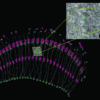The vocalizations of humans, bats, whales, seals and songbirds vastly differ from each other. Humans and birds, for example, are separated by some 300 million years of evolution. But scientists studying how these animals learn to “speak” have time and again seen surprising similarities in the connections in brain regions that support this vocal learning.
In a paper published in the journal Science, a multi-institutional team led by scientists at Carnegie Mellon University and the University of California, Berkeley has found parts of the genome, both within genes and outside them, that have evolved and are associated with vocal learning across mammals.
Employing a machine learning approach called tissue-aware conservation inference toolkit (TACIT) on the Pittsburgh Supercomputing Center’s Bridges-2 system, the laboratory of Andreas Pfenning identified 50 gene regulatory elements from the brains of humans, bats, whales and seals that have a stronger relationship to vocalization. These regulatory elements are DNA sequences outside the actual genes that direct what genes are active in which tissues.
Scientists have come to understand that regulatory elements play a big role in the evolution of behaviors. But studying them has been much more difficult than studying the genes.
“New artificial intelligence methods were needed to help find evolutionary signals in regulatory elements across hundreds of genomes,” said Pfenning, a corresponding author on the new study and an associate professor in CMU’s Ray and Stephanie Lane Computational Biology Department affiliated with the Neuroscience Institute and Department of Biological Sciences. “We’re entering an exciting era where AI is improving our ability to trace human evolutionary history. Studying the gene regulatory elements requires building a map of which ones are active in the relevant brain region of species with vocal learning behavior.”
That relevant brain region was found through experiments conducted in the laboratory of UC Berkeley’s Michael Yartsev, another corresponding author. They found evidence that a specific part of the Egyptian fruit bat brain has similar neural connections to the part of the human brain that controls speech production.
“Very few mammals are actually capable of learning the sounds that they make, which makes it very difficult to study this core aspect of humanity,” said Yartsev, an associate professor of bioengineering and neuroscience at UC Berkeley. “We were able to identify parallels between bats and humans in the structural elements of the brain, the genetic content, and even the neural circuitry that control vocal learning.”
Both vocal-learning-associated genes and the gene regulatory elements discovered in this study also tend to reside in parts of the genome related to autism spectrum disorder. This finding suggests that studying the evolutionary history of the human genome can provide clues to how it influences human health.
“The types of cells that form long-range connections in the human and bat brain are the same ones that we discovered as most relevant to vocal learning based on the genetic analysis,” Pfenning said. “The anatomy and genetics are both pointing to the same mechanism underlying the evolution of vocal learning across mammals and speech production in humans.”
More information:
Morgan E. Wirthlin et al, Vocal learning-associated convergent evolution in mammalian proteins and regulatory elements, Science (2024). DOI: 10.1126/science.abn3263
Provided by
Carnegie Mellon University
Citation:
Similar genetic elements underlie vocal learning in mammals (2024, February 29)



